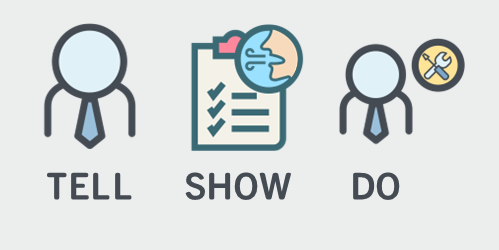Which Areas Should You Focus On For Rapid eLearning Material Development?
Unfortunately, there’s more to rapid eLearning material development than slapping on a fresh coat of paint. In other words, you can’t simply convert Flash to HTML5 and add a few images to achieve the desired results, which raises the question: what should you include to improve employee engagement and reduce L&D expenses? There’s nothing wrong with converting existing content. In fact, it’s one of the best ways to stretch resources and streamline content development. You can also translate materials to expand your reach and improve online training accessibility. But there are a few key areas to focus on when starting your rapid eLearning design process, especially if you need to create high-quality content that’s relevant and immersive.
1. Interactivity
Next-level serious games and expensive simulations usually come to mind when people think of interactivity. In truth, it’s a pretty big umbrella that covers everything from transitions to drag-and-drop interactions, as well as graphics, hot spots, and polls. You don’t have to spend a small fortune to grab their attention. The goal is to get employees to engage with the content instead of just passively reading what’s on the screen. That way, they assimilate the information and quickly process it through their working memory. They might even move it to their long-term memory banks if you play your cards right.
2. Relevancy
One of the main challenges that rapid eLearning can help you address is relevancy. Say that you have a webinar that’s been collecting dust for a year. It has outdated topics and tips that no longer resonate with staffers. Or maybe it’s a Flash-based activity that’s no longer accessible on mobile devices. Thankfully, eLearning content conversion can help you give those assets a new lease on life. It’s not a matter of simply putting it into a different format, you also add fresh materials to modernize resources and improve relatability. For instance, updated images, sound bites, and graphs that tie into job duties.
3. Real-World Application
It’s not enough to just memorize the subject matter. Staffers need to be able to apply it in the workplace to reap all the L&D benefits. As such, your rapid eLearning design must have a real-world application to put everything into context. This also allows employees to reflect on their performance habits and spot areas for improvement. Once again, it doesn’t have to be anything fancy. If you can’t afford simulations and branching scenarios, consider practical examples, stories, and recorded task tutorials. Show them how to apply everything they’ve learned in the real world and boost their self-confidence.
4. Personalization
Most employees expect one-size-fits-all rapid eLearning when they log into the platform, mainly because it’s what they’ve encountered in the past. Imagine their surprise when they find personalized resources that actually help them on the job. Add some personal touches that make the experience memorable, such as challenges they face in the workplace and role-specific activities. You should also include immediate and personalized feedback so they can bridge gaps autonomously, like follow-up resource links or recommendations.
5. Self-Assessment
Knowledge checks are always a key ingredient for rapid eLearning design since they give employees the chance to evaluate their own strengths and weaknesses as well as track progress to see how far they’ve come and where they need to go. This may be in the form of a pop quiz, real-world simulation, or even a group discussion, and you can incorporate all these elements into your rapid eLearning course. For example, add a pop quiz between each module so they can evaluate performance before moving on. They might even choose to pause the course and address gaps right away, thanks to the JIT online training library.
6. Reinforcement
Rapid eLearning is ideally suited for knowledge reinforcement because of its quick turnaround time. You can develop memory refreshers and content updates to improve long-term retention. For example, employees need to know about recent regulatory changes, but they must also recap some of the underlying policies and protocols that are still in effect. Rapid eLearning content allows them to do both without overhauling the entire compliance course.
7. Diversification
Content diversity breaks up the monotony and custom-tailors the rapid eLearning experience. Employees can choose activities that align with personal preferences, or the course already includes a good mix of activities, assessments, and JIT resources to alleviate boredom. As an example, the 20-minute module has hands-on activities and visual examples for employees to follow, but there’s also a checklist for staffers who prefer text-based online training and a more methodical approach.
8. Support
You can’t just dump information on your employees and leave them to their own devices. Support is key for staffer satisfaction and talent development, even if it’s a link to an online discussion forum or social media group where they can find pointers. Some other cost-effective support ideas are peer coaching and mini-repositories, for instance, a small microlearning library that relates to the subject matter. You don’t even have to create resources from scratch. Simply compile pre-built assets so that employees can find all the information in one spot.
Conclusion
There’s a popular myth that rapid eLearning design is a shortcut that results in generic content. Sadly, there is a grain of truth to it, as many organizations overlook these crucial areas and simply convert their PowerPoint presentations minus all the interactive elements, real-world application, and personalization. This is yet another reason you may want to outsource at least some of your rapid eLearning material development. A content provider can help you disclose gaps and modernize your L&D assets to bridge them.

Homebase
Make work easier. Running a small business has never been harder. Homebase helps with free tools to track time and manage your team.




















